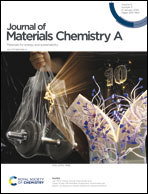Elevated efficiency and stability of hole-transport-layer-free perovskite solar cells induced by phenethylammonium iodide†
Abstract
Despite organic–inorganic hybrid perovskite devices having reached a photoelectric conversion efficiency (PCE) of 26.1%, their high cost and poor stability limit their industrial applications. Density functional theory (DFT) calculation reveals that the major defects originate from the lead vacancy (VPb) on the perovskite film surface. Therefore a two-dimensional material, phenethylammonium iodide (PEAI), was applied to passivate Pb2+ defects in the perovskite film. Theoretical studies show that uncoordinated Pb2+ can be effectively passivated, and in the meanwhile PEAI binds to iodine vacancies (VI) on the perovskite film surface through Lewis base–acid interactions, resulting in a significant decrease in trap density and a prolonged charge lifetime. The PEAI passivation leads to interfacial hole transfer, causing the band edge of the perovskite to move upward. We designed and constructed PSCs with carbon electrodes without hole transport layers, achieving the highest PCE of 17.27% and excellent stability. This strategy provides a useful reference for elevating the PCE and stability of perovskite cells.



 Please wait while we load your content...
Please wait while we load your content...